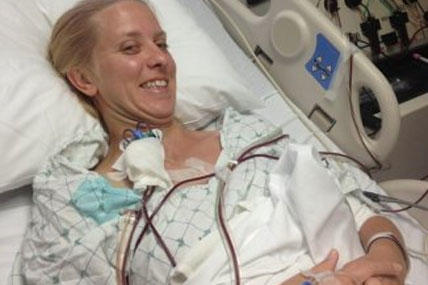FORT BRAGG, N.C. -- Volunteering to become a Soldier in the U.S. Army is a commitment requiring dedication, sacrifice and courage. Soldiers often lead a life of voluntary service to the community in other ways than honoring their countrymen through duty.
Spc. Amanda N. Reynolds of Weleetka, Okla., serves as an investigator in the 42nd Military Police Detachment, 16th MP Brigade, out of Fort Bragg, N.C. In addition to her commitment as a Soldier, Reynolds is a very dedicated and giving person. She is actively involved in the C. W. Bill Young Department of Defense Marrow Donor Program, a life-sustaining program open to all healthy people between the ages of 18 and 60.
Reynolds registered as a donor in Oklahoma and the DoD donor program. She had never really considered the option until one near-death experience made her realize the importance and fragile nature of life.
Reynolds has been a military policewoman in the U.S. Army for seven years, deploying to Baghdad, Iraq, twice for her country. Reynolds was part of the elite Military Police Soldiers who are also airborne paratroopers.
One day in October 2011, was her last scheduled jump on jump status. Soldiers on jump status receive additional pay for the hazardous task of parachuting. In turn, they are required to complete a variety of jumps regularly. She was scheduled for a night jump, and fatefully it turned out to be her last jump unexpectedly.
"I jumped out of the airplane just after 10:30 p.m., and quickly noticed something didn't feel right," said Reynolds. "My chute lost air and I was falling way too fast. It finally caught [air] about 100 feet above the ground. That jolted me, and then, I collided with another paratrooper before slamming into the ground -- feet, butt -- and then my head bounced."
During a successful parachute landing fall, a paratrooper lands with certain body parts hitting in order -- normally balls of the feet, then calf, then thigh, then buttocks, and finally "push up muscle," latissimus dorsi muscle.
The Soldier Reynolds had collided with called out in the darkness asking if she was OK. She thought she was, but quickly realized she could not lift up her head with holding it in her hands. Only then did she realize her combat helmet had gone flying on the initial impact.
"No. I'm not OK," communicated Reynolds.
Reynolds' neck was broken in the landing, and she was soon in emergency surgery. One vertebra had to be completely removed, and bone was taken from her hip to repair other damage. Although it was a series of unfortunate events, there was a silver lining. During the whole hospital process, she learned her bone marrow was unusually healthy and could be used for a bone marrow transplant.
Reynolds found a new motivation to recover from her neck surgery; she would donate her bone marrow to help save someone else's life.
"Her drive to keep going no matter what is amazing," said Spc. Nicki Kempel of Wimauma, Fla., also assigned to 42nd Military Police Company.
Upon receiving confirmation to donate her bone marrow, Reynolds was escorted by Kempel from Fort Bragg, to MedStar Georgetown University Hospital, Washington, D.C., June 21-27. At the hospital, she underwent five days of treatment to stimulate stem cell growth for donation on the fifth day.
"If I can help people out in any way, I am more than willing too, and [donating] is one way it won't hurt me, because bone marrow re-grows, and blood replenishes itself," said Reynolds.
Reynolds received two shots daily, for five day, in the back of the arms to elevate the stem cell count in her blood stream. She had a central line put in to circulate her blood to filter out the stem cells, a process that normally takes six hours. Because she responded so well to the treatments, her blood circulation only took three hours.
"The catheter was placed in my jugular vein using ultrasound, which did not hurt being placed in, but tickled when it was later removed," said Reynolds.
For a process that took only three hours, Reynolds might have made an impact that could last a lifetime. The harvested stem cells are destined for a 6-year-old donor with leukemia.
"If I can help the little boy have a chance at surviving, I will do anything necessary," Reynolds explained.





























